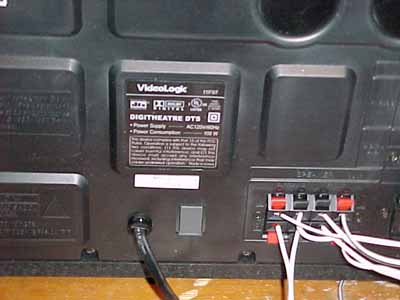VideoLogic DigiTheatre DTS: The Ferrari of Sound is here
by Jim Warren on March 19, 2001 12:30 AM EST- Posted in
- Smartphones
- Mobile
The Setup
The system packs into a surprisingly small box, though its weight indicates that it has the mass to back up its power. It unpacks quickly; the parts list is fairly straightforward. There are four satellite speakers, a control module with an integrated center speaker, the subwoofer, and finally cabling that includes 4 speaker wires and a multipin control cable.

The system comes with placement recommendations designed to help replicate the surround format that DTS program material is mixed for. It suggests an isosceles triangle (equidistant sides) with the user at the vertex, and an apex angle of 70 degrees.

Further layout instructions are included for aligning the center speaker with the front surrounds. They should be in the same horizontal plane (i.e. at the same height), and the center speaker should be even with or slightly behind the vertical plane of the front surrounds. These all should be oriented with the center channel as close to the visual source as possible.

Finally, there are two placement options for the rear surrounds. They should be approximately 2 to 3 feet (60-90 cm) above ear level, and placed so that they either shoot straight across the back wall at each other (the recommendation from VideoLogic), or straight along the side walls.
Once the satellites have been placed, they are wired to the amplifier integrated into the subwoofer enclosure. Four speakers cables are included, two of which are longer and designed for the rear surrounds. All connections are via spring loaded terminal strips, so in the event that the provided lengths are not long enough, any standard speaker wire can be substituted to achieve the desired length for the four satellites.











2 Comments
View All Comments
kikamki - Thursday, June 17, 2004 - link
I liked the almost-in-depth review. However, I have a feeling that the author was somewhat biased (over-awed?).'Backward' compatible to Dolby Digital?? What's that? Are you trying to say that DTS is the next generation (and that much better)? Apart from the theoritical resolution of DTS, I don't think it is perceivably better than comparable Dolby Digital encoded material (perceivably being the keyword here).
I understand that when it comes to judging the quality of audio, in the end, it is highly subjective. But how did you differentiate the quality of DTS encoded material versus Dolby Digital material. DID YOU REALLY FEEL THE DIFFERENCE? Or were you just recycling some marketing material?
I don't prefer DTS or Dolby Digital in particular (I like both), but I think the author is overly excited, and did I mention biased?
Anyway, my own biased viewpoint aside, there is only one thing I wanted to say, really. Please be objective -- like most of the AnandTech reviews; that is why come back to AnandTech again and again.
Thanks.
ki kamki
KristopherKubicki - Friday, March 12, 2004 - link
test